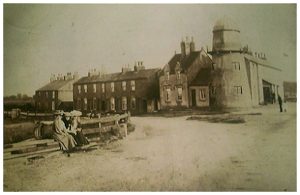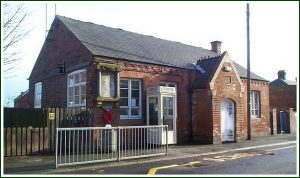THE VILLAGE OF PAULL was originally named Paghil, Latinised into Pagula, which means a stake marking a landing-place. (To this day, the name remains in use in part of Paull as Paghill). The exact date the settlement was founded is unknown, but the village is listed in the Domesday Book, drawn up under the orders of William the Conqueror in 1086, as part of the manor of Burstwick, and it was the duty of Low Paull to provide sufficient men to row the Lord and Lady of the Manor across the Humber from Holderness to Lindsay.
In 1377 the population of Paull was recorded as Paull: 28, Paull Fleet: 140, Paull Home: 61, giving a total of 229, although as this census was for the purpose of a poll tax this could well just be adult males.
The whole of the manor of Burstwick belonged to the Constable family until 1769 when a wealthy Hull merchant, Benjamin Blaydes, bought High Paull and the manor of Paghill for the sum of £6,700 (about £820,000 in modern terms). This seems a remarkable amount to pay for a property which at the time seldom made more than £100 a year, and often incurred major outgoings in repairing the flood banks – one tide alone did damage recorded at over £300 (£43,000 in present value!). Since that time, extensive improvements have been made to the river defences and the village has gained better protection from the sea, resulting in the reclamation of thousands of acres of fertile farmland.
Until relatively recently Paull was a centre for fishing and particularly shrimping; nowadays the many fishermen who still use Paull are there in a purely recreational capacity, although eel traps are still set and sufficient eels caught to be sold commercially to London to make the Cockney delicacy Jellied Eels. Paull has built ships of all kinds for many years, and in 1812 HMS Anson, a 74-gun warship of 1,741 tons was built at Paull – the stocks used can still be seen at low tide on the beach by the old slipway, and the adjacent cottages are known as Anson Villas.
PAULL BATTERY was built on the orders of Henry VIII, but played its first significant role when, in July 1642, during the Civil War in England, King Charles I visited the newly-built Paull Battery to review his forces (it was after this visit that he went to Hull, only to be famously turned away by Sir John Hotham). Later in the same year the Battery was partly demolished by gunfire from Parliamentarian ships sailing up the Humber to relieve the siege of Hull, which at the same time damaged Paull Church with shots meant for the Battery.
It was not until the Crimean war of 1854 – 56 that it was thought necessary to fully repair and rebuild the Battery and it is this building complex which can be seen today. It was occupied by the Royal Artillery and was armed with 19 guns for the protection of the river approaches.
During WW2 the battery continued to be part of Hull’s defences, and until the 1960s it was owned by the Crown before being finally sold off into private ownership. The battery (re-named Fort Paull for business purposes) is now a historical military site with an award-winning museum featuring static displays and re-enactments etc. at weekends during the summer.
 PAULL LIGHTHOUSE was erected in 1836 but was already disused by the 1890s and is now a private home; it replaced leading lights which were shown in the window of the Humber Tavern to help guide ships away from the treacherous sandbanks. More new lights were erected in the late nineteenth century, two at Salt End which fell into disuse with the building of the jetties and two more at Thorngumbald Clough which are still in existence.
PAULL LIGHTHOUSE was erected in 1836 but was already disused by the 1890s and is now a private home; it replaced leading lights which were shown in the window of the Humber Tavern to help guide ships away from the treacherous sandbanks. More new lights were erected in the late nineteenth century, two at Salt End which fell into disuse with the building of the jetties and two more at Thorngumbald Clough which are still in existence.
PAULL PARISH CHURCH, originally dedicated to St. Andrew and later to Saint Mary and Saint Andrew, is now known once more as St. Andrew’s church. There has been a Church at Paull since 1155AD. The precise site of the original church is unknown but we do know that it was near the village and on the banks of the Humber. In the Patents Roll in the 14th century it was described as “almost entirely broken down and inundated” and it was at about this time that it was lost to the Humber, Work to build a new Church began in 1355 to replace the earlier church, on higher ground a quarter of a mile outside the village in order to avoid flood damage. It is in the Perpendicular style, with very thick walls partly built of cobbles from the shore. A thorough restoration was carried out in 1880 and many traces of fire were found, showing the extent of the damage suffered from the the Parliamentary guns in 1642.. The stone and carved oak pulpit dates from 1879, as do the choir stalls, but the east window is from an earlier 13th century building and there is also a simple oak chest which dates from the 11th century. Further restoration and modernisation was carried out in 2009 which included bringing piped water into the church for the first time, the construction of a small kitchen area and the installation of toilet facilities. The Church and the RIverside Pop-in Coffee Shop are open to visitors every Saturday and Sunday between 2 and 4 pm from March to October; church services are held every Sunday. (see the general information page on this site.)
The vicarage was built in 1859: it was sold as a private home when Paull became a joint parish and renamed Beech Rise. Until recently it was a residential home for the elderly,renamed yet again as Paull Manor, but is now back in private ownership as a family home.
Besides the church there have been two chapels in Paull : the Primitive Methodists erected a chapel in 1871 (since converted into two cottages) at the junction of Back Lane and Main Street, and the Wesleyan Methodist Chapel was built in 1805, restored in 1912 and until recently was still in regular use.
PAULL SCHOOL was built in 1863, before schooling became compulsory, and enlarged twice in the next thirty years. No further extensions were added until June 1979, when extra accommodation in the form of a mobile classroom was added. A second mobile classroom (these being supposedly temporary structures) was added soon after and it took the 21st century to bring further building improvements, with work commencing in the summer of 2005.
In 1892 the number of children on roll was 62, although there were places for 100; in comparison, in the latter part of the 20th century numbers fluctuated around 45-65, although of course nowadays the children transfer to South Holderness School in Preston at 11 whereas in the 19th century they would remain in the village for the whole of their school careers.
The school was eventually threatened with closure but vaiant campaigning by the whole village saved the day and in 2005 the County Council built new, modern classrooms. The school now has a nursery, taking children aged from 3 years, and a dedicated Early Years teaching team giving a new vibrancy to the school. Numbers are increasing and many families from the surrounding vilages are choosing to send their children to Paull rather than their much larger local schools, preferring the calmer small-school ‘family’ atmosphere Paull offers.
The school has its own website – click here for more information and photos.
PIER HOUSE on Main Street once housed a Museum of Curiosities, the collection of Mr. Battersby which was open to the general public. Amongst the exhibits was a facsimile of Charles I’s death warrant (now on display at Fort Paull,) a model of Hull Town Hall made out of cork, and the entire skeleton of a Miss Jenkins, known in the locality as “Rabbit Nanny”. She hawked rabbits in the streets of Hull and it was said that her voice could be heard across the river at Barton. She sold her body prior to her death for the sum of £5, for dissection and medical research in Hull, and her skeleton was subsequently bought from a Dr. Hay and put on display; this skeleton is also now one of the exhibits at Fort Paull.
PAULL HOLME was originally the home of the Holme/Hulme family, who took their name from the place and not vice-versa. A brick tower is the sole remaining portion of the Great Hall, built in the 15th century. It stands 30 feet high with battlements and small loophole windows. It is reputedly haunted by the ghost of a cow which, in 1840, somehow climbed up the narrow staircase to the battlements and, unable to get back down, fell to its death. The present farmhouse was built in 1837 out of materials from the Old Hall. In 2005 the Paull Holme Preservation Society was formed, and plans to restore or at least preserve the tower and its environs are now well in hand.
BOREAS HALL on Boreas Hill, north-west of the village, is on one of the few higher points around (a glacial moraine some 15 metres above sea level!) It was formerly Boar House or Bower House, and the grounds once extended to 300 acres.
NEWTON GARTH lies between Paull and Hedon and is on the site of an ancient leper hospital founded in the reign of Henry II (1133 – 1189). During the Reformation of the 16th century the revenues of £40 per annum were seized on behalf of Henry VIII and the inmates turned out.
All history information courtesy of Dianne G. Davies.